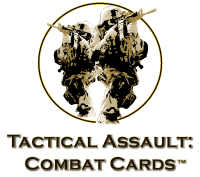Scenario Design… Troop Quality
When designing scenarios, the question often comes up of how to reflect of training, experience leadership and other intangible qualities of a fighting force on the battlefield. In the Combat Cards, there is a very simple and easy mechanism for doing this – the Command Unit. The ability of Command Units to pass Actions along to other nearby units determines how efficiently cards can be played during the battle. This affect on efficiency can be used to elevate units to an elite status for a given scenario, or to downgrade them to a poorly led force.
In setting up a scenario, if the scenario designer requires a minimum number of Command Units for one side, it will assure that that side will be very efficient in its Actions and that it will have a definite advantage on the battlefield. That side will be better able to coordinate its efforts, respond to enemy movements, withdraw from dangerous positions and so on, which translates in to being a more effective fighting force – the trademark of an elite or veteran unit.
On the other hand, if a limit is placed on the maximum number of Command Units a side may have, the force will naturally be slower in responding to the developing battle. Each unit will require a separate card to be played on it so it can move in response to an enemy threat, engage enemy units, and so on. This requires a lot more cards, and therefore a lot more turns of waiting for and collecting those much needed cards. All of which gives the opponent precious time during which they can continue to develop their plans and carry forward their attacks. This slow responsiveness and uncoordinated effort is the hallmark of poorly led, trained or motivated units.
In conveying these limits in a scenario, you will need to keep in mind the structure of the scenario itself. If the scenario is being left open for players to build their own forces (i.e. a “Points Scenario”) then the limits should be given as a percentage of the player’s total force (e.g. no more than 10% can be Command Units, or at least 20% must be command Units, etc.). If the scenario is being written with a more specific force composition in mind (i.e. a “Force Scenario”), the restrictions should be spelled out in a similar fashion (e.g.”Side A has one Command Unit”, or “Side B has five Command Units”).
So as you can see, it is very easy to vary troop quality in a scenario by setting minimums or maximums on the number of Command Units a side may have. The higher or lower those limits are set at, the more profound the impact on the battle – which is exactly the effect training and leadership can have on the battlefield!





